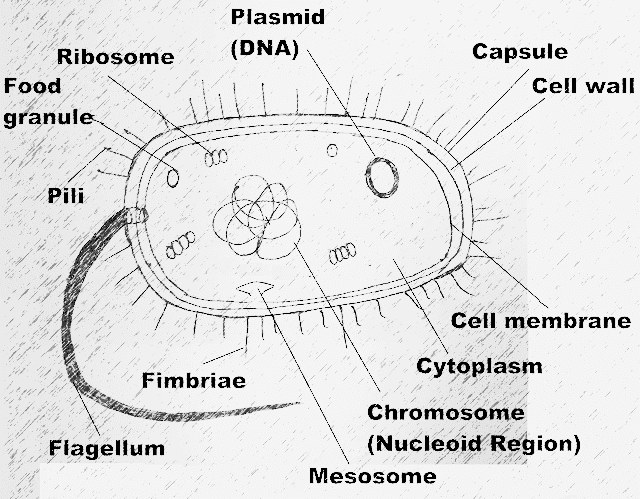Prokaryotic Cell
Prokaryotes are unicellular organisms. Typical prokaryotic cells range from 0.1 to 5.0 micrometers (μm) in diameter and are significantly smaller than eukaryotic cells.
It lacks a nuclear membrane-enclosed nucleus or other
bounded - organelles or other internal membrane-bound structures.
They generally have a
single chromosome; a piece of circular, double-stranded DNA with
in cell called the Nucleoid.
Know here what is cell and cell organelles?
Prokaryotic Cell Diagram

Check out here the difference
between prokaryotic and eukaryotic cell.
Prokaryotic Cell Structure
Prokaryotic cell structure consists of -
1. Capsule
Found in some bacteria, have an outer
layer covering that surrounds the cell wall called the capsule. It protects the
cell when it is engulfed by other organisms.
The capsule helps the bacterium attach to surfaces, and assists
in retaining moisture and nutrients.
2. Cell wall
The cell wall is a protective layer of
bacterial cells that surrounds some cells and gives them shape and rigidity. It
is located outside the plasma membrane and prevents osmotic lysis (bursting due
to increasing volume).
The chemical composition of the cell walls varies between
Bacteria and Archaea and also varies between bacterial species.
3. Cell membrane/ plasma membrane
The plasma membrane is a thin lipid bilayer, It surrounds
the cell's cytoplasm and regulates the flow of substances in and out of the
cell, and separates the inside from the outside.
The cell wall is selectively-permeable in nature; it keeps
ions, proteins, and other molecules within the cell and prevents them from
diffusing into the extracellular environment, while other molecules may move
through the cell membrane.
4. Periplasmic space
Periplasmic space is
the space between the plasma membrane and the outer membrane in Gram-negative
bacteria.
5. Cytoplasm
The cytoplasm consists of
a gel-like substance composed mainly of water, that also contains enzymes,
salts, cell components, cell organelles, cell components, and various
organic molecules.
6. Nucleoid
It is the region in
the cytoplasm where the genetic material is present, that generally has a
single chromosome -a piece of circular, double-stranded DNA located within
a cell called, the nucleoid.
7. Ribosomes
All prokaryotes have
the type of 70S ribosome structure, responsible for protein synthesis
production.
8. Plasmids
They naturally
exist in bacteria. A plasmid is a small, extrachromosomal DNA molecule
(non-chromosomal DNA molecule structures) within a cell, It is physically
separated from chromosomal DNA and can replicate independently.
9. Flagellum
These are long structure;
whip-like protrusion that helps in cellular locomotion used by both
gram-positive and gram-negative organisms.
10. Pili (Pilus)
These are rod-shaped,
hair-like outgrowths structures on the surface of the cell that attach to the
surface of other bacterial cells and also aid in DNA transfer. Shorter pili
called fimbriae, help bacteria attach to surfaces.
11. Fimbriae
Fimbriae are thin,
hair-like outgrowths structures on the surface of the cell, that
help with cellular attachment.
12. Mesosome
Mesosomes are folded
invaginations (pouch formed by being turned inside out or folded back) in the
plasma membrane.
They help increase the
surface area of the cell and plasma membrane and increase enzyme content,
aiding the cell in cellular respiration, and secretion. Mesosomes also help
in cell wall formation.
13. Inclusion body
In prokaryotic cells,
the inclusion body occurs freely inside the cytoplasm of the cell. They are
mainly formed to store reserve materials, reserve carbohydrates, and
energy, and store excess nutrients.
Check out here structure
of eukaryotic cells.
Reproduction in Prokaryotes
In prokaryotes, organism reproduces
asexually by binary fission and they can also exchange genetic material by
transformation, transduction, and conjugation.
Bacteria and Archaea
reproduce through -
1. Asexual reproduction, usually by binary
fission.
2. Recombination
A. Binary Fission
1. Replication of DNA
Binary fission begins
with DNA replication of a single DNA molecule. Both copies of DNA attach to
the cell membrane means the DNA of an organism replicates and the new copies
attach to the cell membrane.
2. Growth of cell
Next, the cell
membrane begins to grow between the two DNA molecules. The cell wall starts
increasing in its original size and the cell membrane starts moving inwards.
3. Separating of DNA
A cell wall is then
formed between the two DNA molecules dividing the cell into two identical
daughter cells.
4. Splitting of cell
Two identical daughter
cells formed.
B. Prokaryotic Recombination
In recombination, genes from one prokaryote are incorporated into the genome of another prokaryote. Genes
from one bacteria are transferred to the genome of other bacteria.
1. Conjugation
Process in which genes
are transferred between two bacteria through a protein tube structure called a pilus
(hairlike appendage).
Bacteria connect through a protein tube
structure, pilus, and genes are transferred through the pilus between bacteria.
2. Transformation
In which the bacteria
take up DNA from their surrounding environment and DNA is taken by the
bacterial cell membrane and incorporated into the bacterial cell’s DNA,
so the alteration of a bacterial cell is caused by the transfer of DNA from
another, especially if pathogenic.
3. Transduction
A mechanism in
prokaryotes, in which process the genetic material is transferred into the
bacterial cell with the help of viruses means genes are transferred using a
virus.
For example, the Bacteriophage virus initiates the
process. First bacteriophages, viruses that infect bacteria, transfer bacterial
DNA from previously infected bacteria to any additional bacteria that they
infect.
Transduction involves the exchange of
bacterial DNA through viral infection.







0 Comments